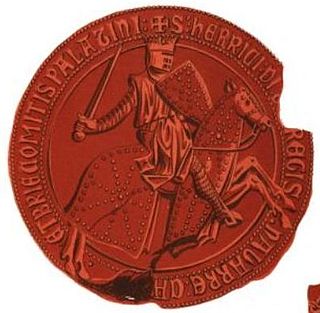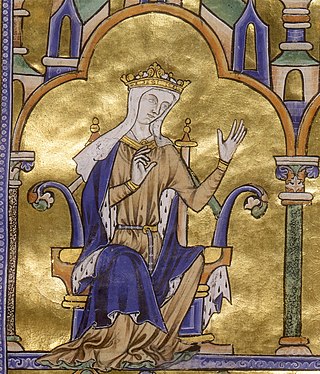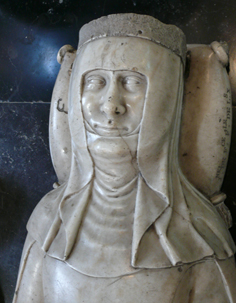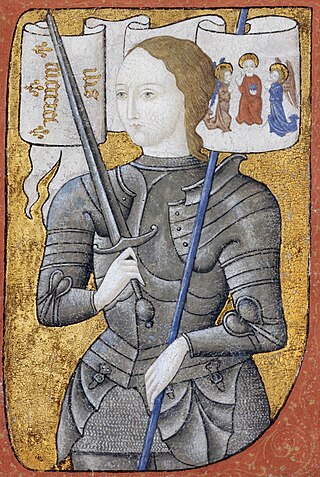Leonora of Castile or Eleanor of Castile may refer to:

Constance is a primarily feminine given name in use since the Middle Ages that is derived either from Constantia, a Late Latin name, or from the term meaning steadfast. In medieval England, diminutives of the name included Cust or Cussot. Puritans used Con, Constant, and Constancy. Other variations of the name include Connie, Constancia, and Constanze.

Henry the Fat was King of Navarre and Count of Champagne and Brie from 1270 until his death.

Blanche of Castile was Queen of France by marriage to Louis VIII. She acted as regent twice during the reign of her son, Louis IX: during his minority from 1226 until 1234, and during his absence from 1248 until 1252.

Eleanor is a feminine given name, originally from an Old French adaptation of the Old Provençal name Aliénor. It was the name of a number of women of royalty and nobility in western Europe during the High Middle Ages. The name was introduced to England by Eleanor of Aquitaine, who came to marry King Henry II. It was also borne by Eleanor of Provence, who became queen consort of England as the wife of King Henry III, and Eleanor of Castile, wife of Edward I.

Charles III, called the Noble, was King of Navarre from 1387 to his death and Count of Évreux in France from 1387 to 1404, when he exchanged Évreux for the Duchy of Nemours.

Theobald I, also called the Troubadour and the Posthumous, was Count of Champagne from birth and King of Navarre from 1234. He initiated the Barons' Crusade, was famous as a trouvère, and was the first Frenchman to rule Navarre.

Joan I was ruling Queen of Navarre and Countess of Champagne from 1274 until 1305. She was also Queen of France by marriage to King Philip IV. She founded the College of Navarre in Paris in 1305.

Joan II was Queen of Navarre from 1328 until her death. She was the only surviving child of Louis X of France, King of France and Navarre, and Margaret of Burgundy. Joan's paternity was dubious because her mother was involved in a scandal, but Louis X declared her his legitimate daughter before he died in 1316. However, the French lords were opposed to the idea of a female monarch and elected Louis X's brother, Philip V, king. The Navarrese noblemen also paid homage to Philip. Joan's maternal grandmother, Agnes of France, and uncle, Odo IV of Burgundy, made attempts to secure the counties of Champagne and Brie to Joan, but the French royal troops defeated her supporters. After Philip V married his daughter to Odo and granted him two counties as her dowry, Odo renounced Joan's claim to Champagne and Brie in exchange for a compensation in March 1318. Joan married Philip of Évreux, who was also a member of the French royal family.

Joan is both a feminine form of the personal name John given to females in the Anglosphere; and the native masculine form of John in the Catalan-Valencian and Occitan languages. In both cases, the name is derived from the Greek via the Latin Ioannes and Ioanna, and is thus cognate with John and related to its many forms, including its derived feminine forms.

Blanche of Artois was Queen of Navarre and Countess of Champagne and Brie during her marriage to Henry I of Navarre. After his death she became regent in the name of their infant daughter, Joan I. She passed on the regency of Navarre to Philip III of France, her cousin and her daughter's prospective father-in-law, but retained the administration of Champagne. She later shared the government of Champagne with her second husband, Edmund, until her daughter reached the age of majority.
Blanca of Navarre may refer to:

Blanche of Navarre, also known as Blanche of Champagne, was the daughter of Theobald the Troubador, King of Navarre and Count of Champagne, and his second wife Agnes of Beaujeu. She was a member of the House of Champagne. By her marriage to John I, Duke of Brittany, she became Duchess consort of Brittany.
Queen Blanche may refer to:
Countess of Richmond is a title that was given to the wife of the Earl of Richmond. Women who have held the title include:
Isabella of France, was the daughter of Philip IV of France and Joan I of Navarre, queen consort of Edward II of England and mother of Edward III of England.

Margaret of Bourbon was Queen of Navarre and Countess of Champagne from 1234 until 1253 as the third wife of Theobald I of Navarre. After her husband's death, she ruled both the kingdom and the county as regent for three years in the name of their son, Theobald II of Navarre.

Isabella is a feminine given name, the Latinate and Italian form of Isabel, the Spanish form, Isabelle, the French form, and Isobel, the Scottish form of the name Elizabeth. All are ultimately derived from the Hebrew Elisheba, meaning God is my oath. Isabella has been in wide use in the Anglosphere since the 1700s and has been a popular name in recent years. It is particularly well used for Hispanic girls in the United States. A common diminutive form is Bella. It may refer to:













